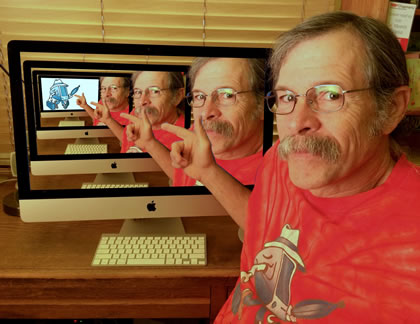Episode #795
April 27, 2024
It begins in Brother Tim’s freshman high school algebra class.
We are solving for variables. I just don’t get it.
“This is baffling to me Brother,” I say.
“What don’t you understand, Rick?
“Why do we perform the same operation on both sides of the equal sign?”
“I hate to state the obvious, but everything on the left side of the equal sign is always the same as what is on the right side. If you do something to one side, you must do the same thing to the other.”
Lights and bells and a great shaking in my head happens. Of course…
left equals right.
This realization proves valuable to me since programming and computers lean heavily on algebra.
I am playing Adventure on one of the Notre Dame computers. It is a text-based Interactive Fiction (IF) computer program. I run along a path, throw a bomb onto the pile of rocks blocking a cave and dash inside to confront whatever lurks within. I am pretty good at using this computer.
My first computer is an Imagination Machine. It is a game console like the Atari 2600 with a cartridge slot to plug in various games. The system connects to my television set. A few games are built in. My friend Pat and I are playing Pong.
I have plugged the keyboard/cassette drive module into the console. It attaches through the cartridge slot. The keyboard allows me to access the Motorola 6800 8-bit processor and a built-in version of Basic programing language. There is 9 kb of RAM to work with. I have written a program to play Simon. A sequence of four colored lights displays and the player moves the joystick to select the same sequence. It starts with one light, then progresses to 2, 3, 4, etc. as long as the player can duplicate the sequence. The program is saved to cassette tape. Data occupies one stereo track and you can put instructions or music on the other track to play while the program is loading.
Pat is a programmer. I show him the Simon program. I start the cassette drive. Carly Simon sings “Mockingbird” for two minutes while 9K of program loads into the computer. Finally, we can play the game. I show Pat how it works and he takes a shot at playing it.
“Fantastic Rick. It runs fast and smooth,” he says.
I fetch a paper printout of my program. It is four typewritten pages of code. Pat studies the program.
“The best thing about this program is how well it runs, but I think this would do the same thing.”
He writes two paragraphs on the back of one of the pages. The first paragraph is the program sequence and joystick controller code. The second is a repeating routine that flashes the lights.
Comparing my spaghetti programing to Pat’s elegant code, I realize that I am not going to be a programmer. I am, however, an excellent user.
My next computer is a 1984 original Macintosh. It has the newer Motorola 68000 processor with a whopping 128K of RAM. I don’t program this computer at all, but I have become adept at using the programs that come on it. MacWrite is the best typewriter I have ever owned. MacPaint tickles my inner illustrator. MacProject opens doors for me at the trade show business where I work.
Having been promoted to project manager at Grondorf, Field and Black (GFB) exhibit house I lay out the current exhibit jobs on MacProject’s PERT (Program Evaluation and Review Technique) charts. The jobs run smoother and are more profitable thanks to my Macintosh. Soon, I am promoted to estimator.
My day as estimator at GFB includes consulting with Design over the buildability of their exhibit renderings. Produced with the help of the Filemaker database program on my Mac, I deliver proposals to Sales. Exhibit proposals that have sold are converted to work orders. Completed work orders are converted to invoices so the company can be paid. In addition, I advise the Design and Graphics departments to specify and purchase Macintosh computers and programs for graphic editing and rendering.
I am so familiar with Macintosh computers that I form a company where after hours and on weekends I tutor users on how to use and troubleshoot their Macs. The name of the company is iMentor. My slogan is “I can teach you half as much about your computer as your kids know.”
After many years at GFB, the exhibit house closes. Rather than moving sideways to a competitor I reinvent myself as the iMentor.
Apple employees cannot make house calls. They must work at the Apple campus or at an Apple store. The Apple Consultants Network (ACN) was created to dispatch certified consultants from the Apple Store Genius Bar to client’s homes. I waste no time joining the ACN.
Today I am chatting with a genius at the South Coast Plaza Apple store.
“That was a weird one,” I say.
“Who would have thought that a user’s cat could evoke a four key shortcut that would invert the monitor image,” marvels the genius.
“I know, Mary doesn’t even know where those shortcut settings are, but her cat knows how to walk across her keyboard.” We both laugh.
My business model is to empower my clients to learn how to solve their own problems.
My colleagues say, “If you do that, then you won’t get return business.
“Not for the same problems,” I say. “But, when a client learns how to solve problems, they become my best salesmen. They recommend me to friends and relatives. ‘Give a man a fish, and you feed him for a day; teach a man to fish and you feed him for a lifetime.’”
This policy has grown my business exponentially.
Another service I have started is a tech tips and hints blog. The iMentor Hints and Rants blog at theimentor.com is a free how-to blog dealing with everything from Apple products to the Internet. The blog is a surprise marketing tool. Clients on my mailing list and those who read the blog regularly call me for 6-7 appointments each week.
There was a time when I thought I would be a teacher. I am now a technician, a teacher, a counselor and a psychologist. What a fun career this has been.
And here is the best advice I ever gave a client, at no charge to you:
“Never trust a computer. Trust in yourself… the user.”
Now that I am retired, I still write the iMentor Hints and Rants blog. It has little to do with computers and everything to do with the human condition. The blog is still free and is a labor of love.
IF YOU LIKE THIS BLOG YOU’LL LOVE MY BOOKS:
“Skydivers Know Why Birds Sing” by Ricki T Thues is now available on Amazon.
It is a Love story of Rick and Paula Thues and their 35 years of Skydiving.
Click HERE to buy the paperback or Kindle ebook at Amazon.
Follow Ricki T Thues on Amazon HERE.
ALSO AVAILABLE:
“Technically Human” by Ricki T Thues, the iMentor, is available on Amazon.
It is a compilation of selected episodes from this bLog which tell the story of Humanity through the eyes of the iMentor.
Click HERE to buy the paperback or Kindle ebook at Amazon.
The ebook version of “Technically Human” is also available on Kobo. Click HERE.
For you Barnes and Noble Nook readers it is available for Nook. Click HERE.
The “Technically Human” ebook is also available on Apple Books . Click HERE.




